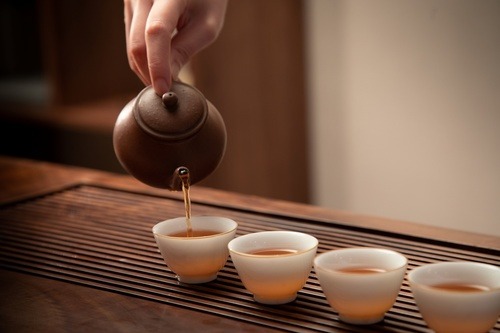In an effort to bring the beauty and depth of Chinese culture to our community, we are proud to present, for the second year, a stunning display of traditional artifacts at our local library. This carefully curated exhibition showcases an array of historical and artistic treasures, offering visitors a glimpse into China’s rich cultural heritage. From the serene symbolism of Buddhism tea culture to the exquisite craftsmanship of tea sets, each piece tells a story of tradition, philosophy, and artistry that has been cherished for centuries.
Buddha Statue and the Chinese Tea Culture 佛像与茶文化的融合
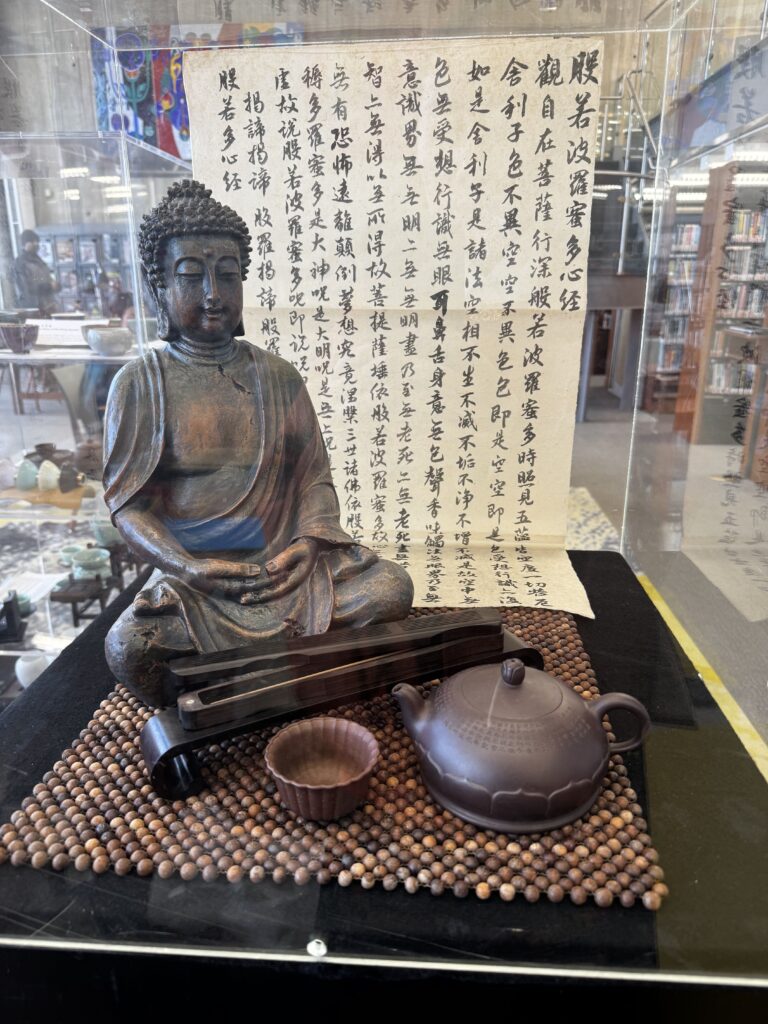
This display embodies serenity and mindfulness. A Buddha statue symbolizes wisdom, while a teapot inscribed with the Heart Sutra reflects the depth of tea culture and Buddhist philosophy. A lying incense burner adds a meditative touch, creating a harmonious space for contemplation and inner peace.
5 Famous Kilns of the Song Dynasty 宋代五大名窑
The Song Dynasty (960–1279) was the golden age of Chinese porcelain, with five major kilns producing some of the most exquisite ceramics in history. These legendary kilns—Ru, Ge, Ding, Jun, and Guan—set the standard for elegance and craftsmanship, each with its distinct artistic characteristics:
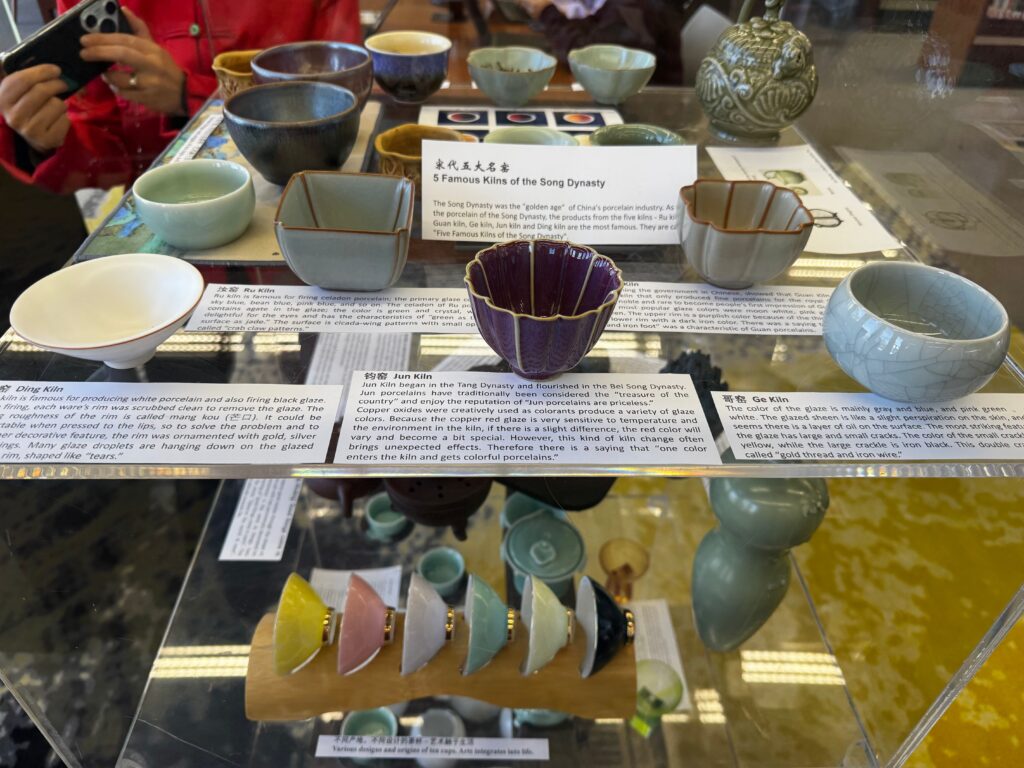
- Ru Kiln (汝窑): Known for its delicate celadon glaze with hues of sky blue, bean green, and pinkish blue, Ru porcelain is celebrated for its jade-like quality and fine crackle patterns.
- Ge Kiln (哥窑): Distinguished by its double-layer crackled glaze, featuring golden and iron-colored veins, giving each piece a unique aged appearance.
- Ding Kiln (定窑): Famous for its ivory-white porcelain with unglazed rims, often adorned with gold, silver, or copper linings for an elegant touch.
- Jun Kiln (钧窑): Renowned for its striking glaze colors achieved through copper oxidation, resulting in vibrant hues that change unpredictably in the kiln.
- Guan Kiln (官窑): Reserved for royal use, Guan porcelain is characterized by its refined glaze, with shades of moon white, pink green, and deep emerald.
Celadon Tea Set 青瓷茶套
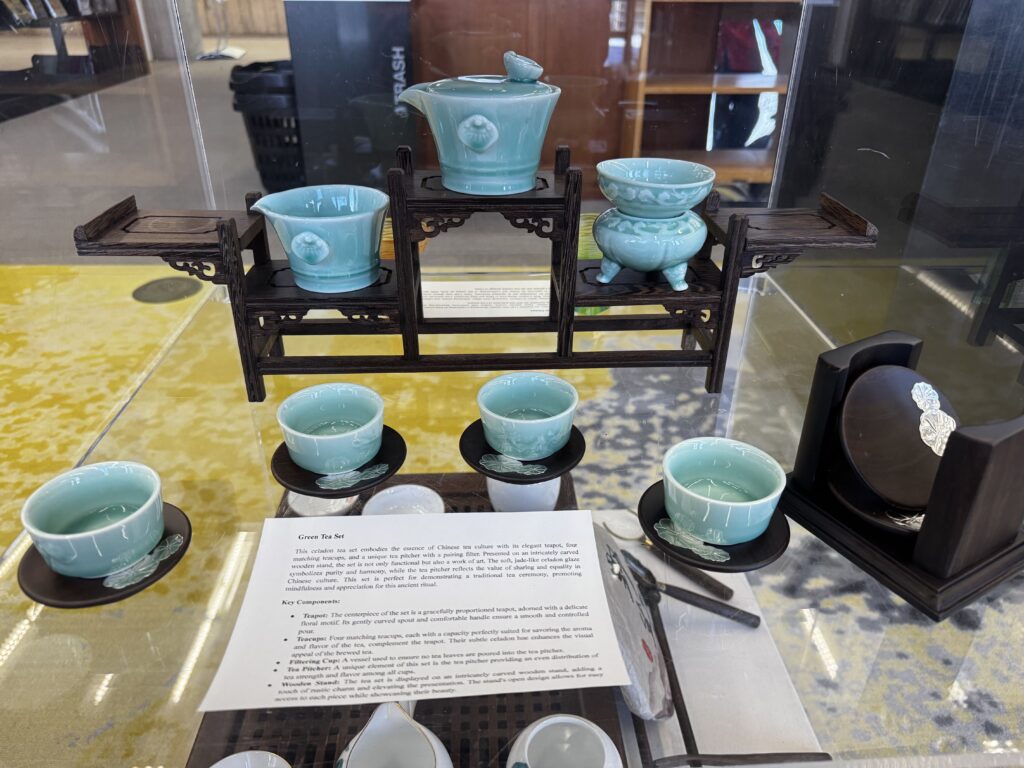
This celadon tea set embodies the essence of Chinese tea culture with its elegant teapot, four matching teacups, and a unique tea pitcher with a pairing filter. Presented on an intricately carved wooden stand, the set is not only functional but also a work of art. The soft, jade-like celadon glaze symbolizes purity and harmony, while the tea pitcher reflects the value of sharing and equality in Chinese culture. This set is perfect for demonstrating a traditional tea ceremony, promoting mindfulness and appreciation for this ancient ritual.
Lotus Tea Set 荷花茶套
This delicate porcelain tea set, adorned with a graceful lotus motif, encapsulates the serene beauty and refined elegance often associated with Chinese tea culture. Each of its tea cups features a unique hand-painted design, showcasing various aspects of the lotus theme. When tea is poured into these cups, it creates a miniature pond-like scene that evokes tranquility and harmony.
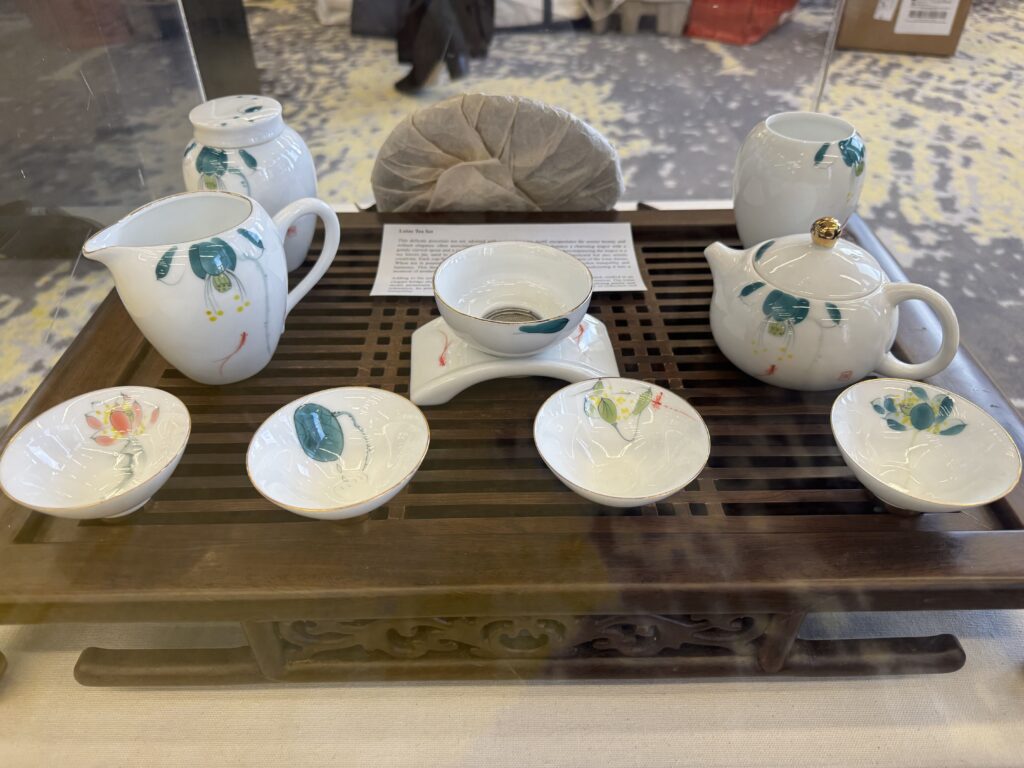
Adding to the set’s functionality and visual appeal is a tea leaf filter with a stand. The stand, crafted in an elegant bridge shape, mimicking ancient Chinese bridge design into the graceful presentation. The lotus motif, prominent throughout the set, holds deep cultural significance in China, symbolizing purity and relaxation. Its presence on this tea set transforms the act of tea drinking into a moment of reflection and tranquility.
Purple Clay Teapot and Good Things Come in Pairs Tea Set 紫砂壶和好柿(事)成双壶
The purple clay teapot is a traditional teapot in China, which is said to have originated from the Song Dynasty (A.D. 902)) to the ZhengDe period of the Ming Dynasty (A.D. 1506). The material used to make purple clay pots is Yixing purple mineral soil, which is also called Yixing purple clay because it is produced in Yixing, Jiangsu Province.
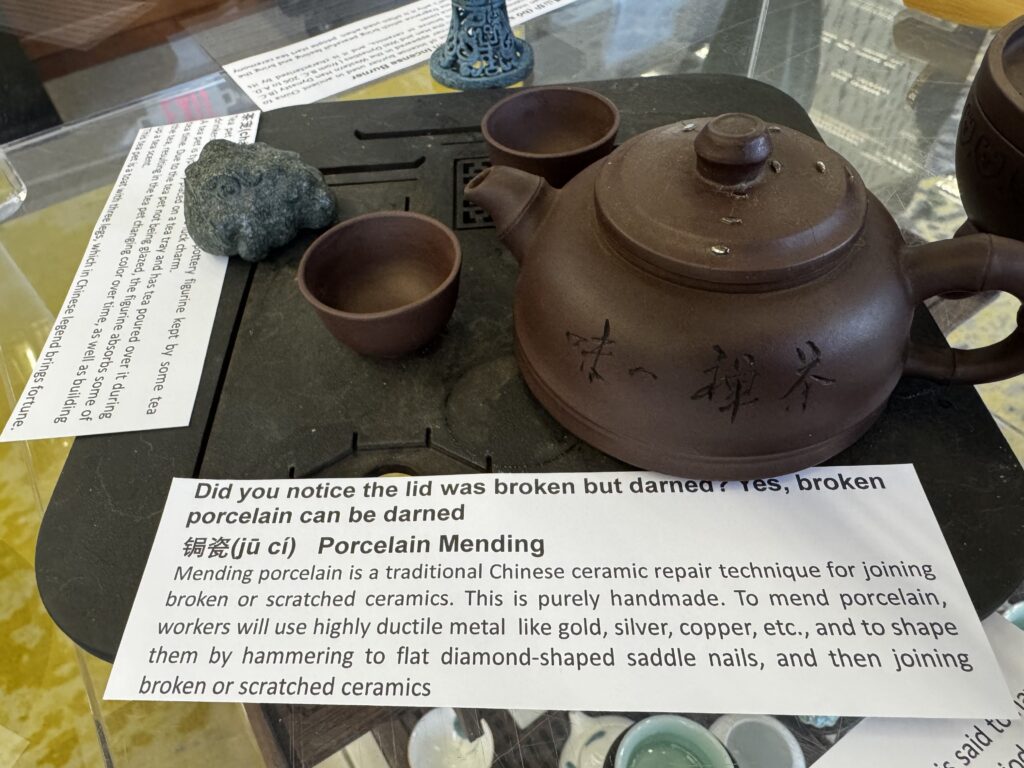
Due to the combination of clay and kiln firing (reduction firing), the purple clay teapot has a special double pore structure which can fully breathe and change the aroma and taste of tea. Therefore, the tea brewed in the teapot becomes more fragrant and mellow. Tea will not go bad even if it is left overnight in a purple clay teapot.
When the purple clay teapot contacts with water, a small amount of white powdery nitric oxide will be produced on the surface. This is the process of oxidation, time after time, the teapot’s color gradually becomes darker and glossed.
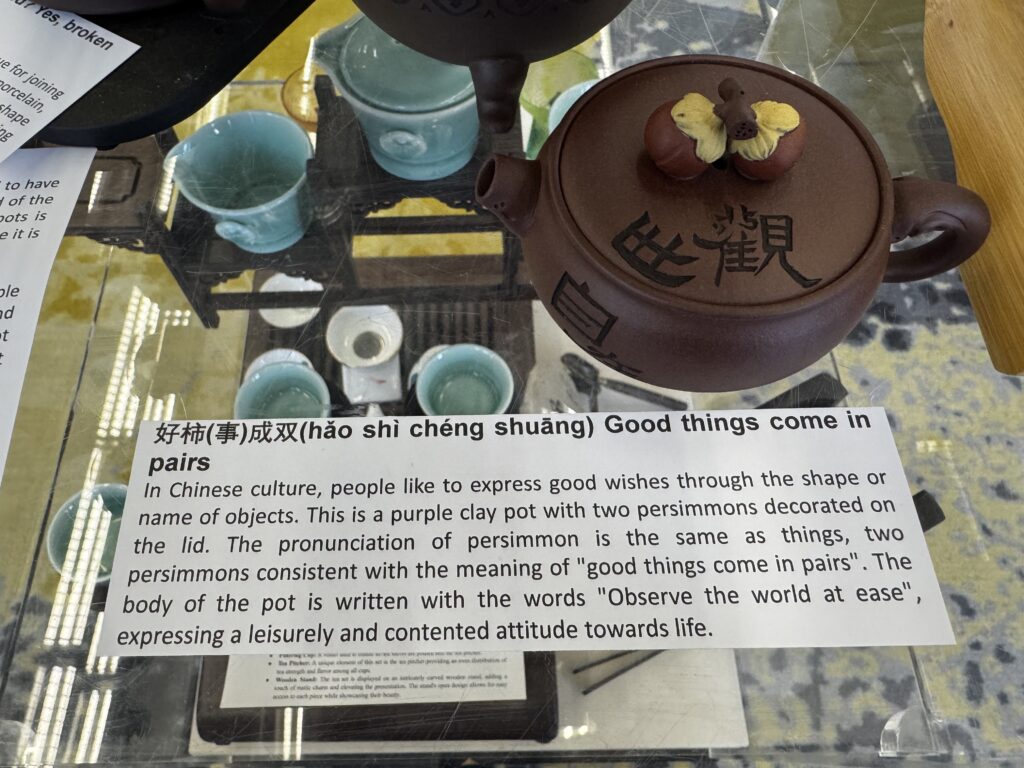
In Chinese culture, people like to express good wishes through the shape or name of objects. This is a purple clay pot with two persimmons decorated on the lid. The pronunciation of persimmon is the same as things, two persimmons consistent with the meaning of “good things come in pairs”. The body of the pot is written with the words “Observe the world at ease”, expressing a leisurely and contented attitude towards life.
Traditional Chinese Tea Accessories 传统中国茶具配件
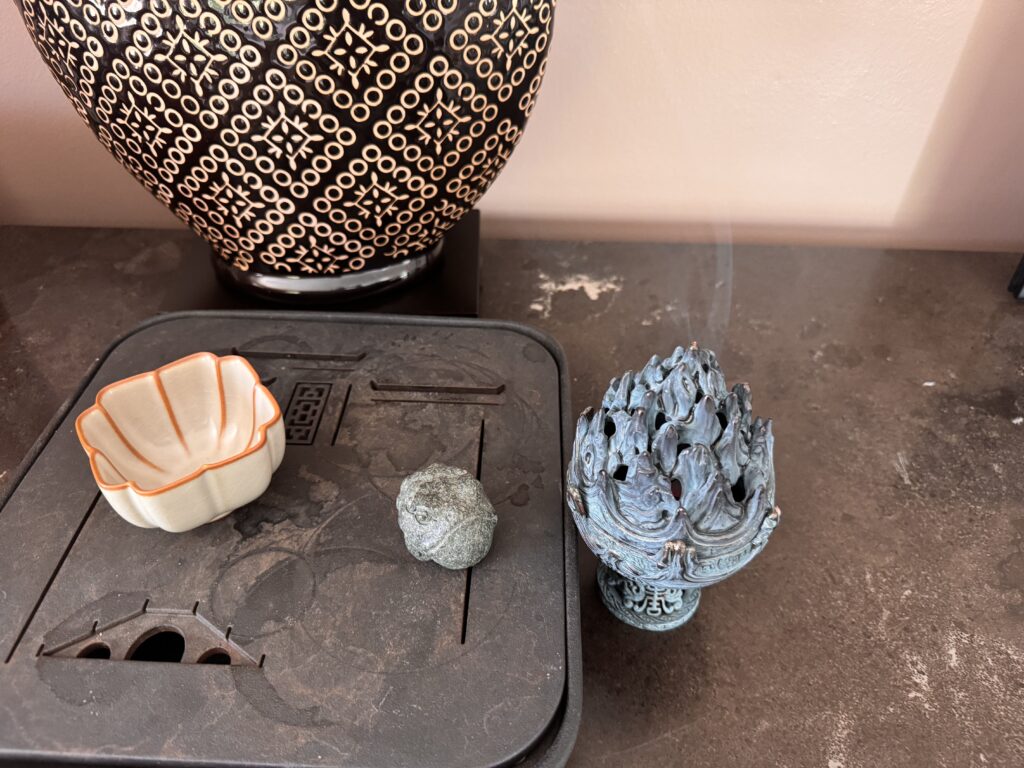
- Boshan Incense Burner (博山炉): A mountain-shaped incense burner, dating back to the Han Dynasty, traditionally used to create a calming atmosphere.This burner first appeared in the Western Han Dynasty (B.C. 206) and became popular in the Han and Wei Dynasties (from B.C. 206 to A.D. 266). Its main material is bronze or ceramics, and it is characterized by its mountain-shaped furnace cover.
- Tea Tray (茶盘): A crucial component of the Gongfu tea ceremony, allowing excess liquid to drain away elegantly.
- Tea Pet (茶宠): Small clay figurines that absorb tea over time, gaining a rich patina and carrying symbolic meanings of prosperity and good luck. A tea pet is typically placed on a tea tray and has tea poured over it during tea time. It can absorb tea liquid and change color over time, as well as contributing as a tea scent diffuser.
Liuli Wine Glasses 琉璃杯
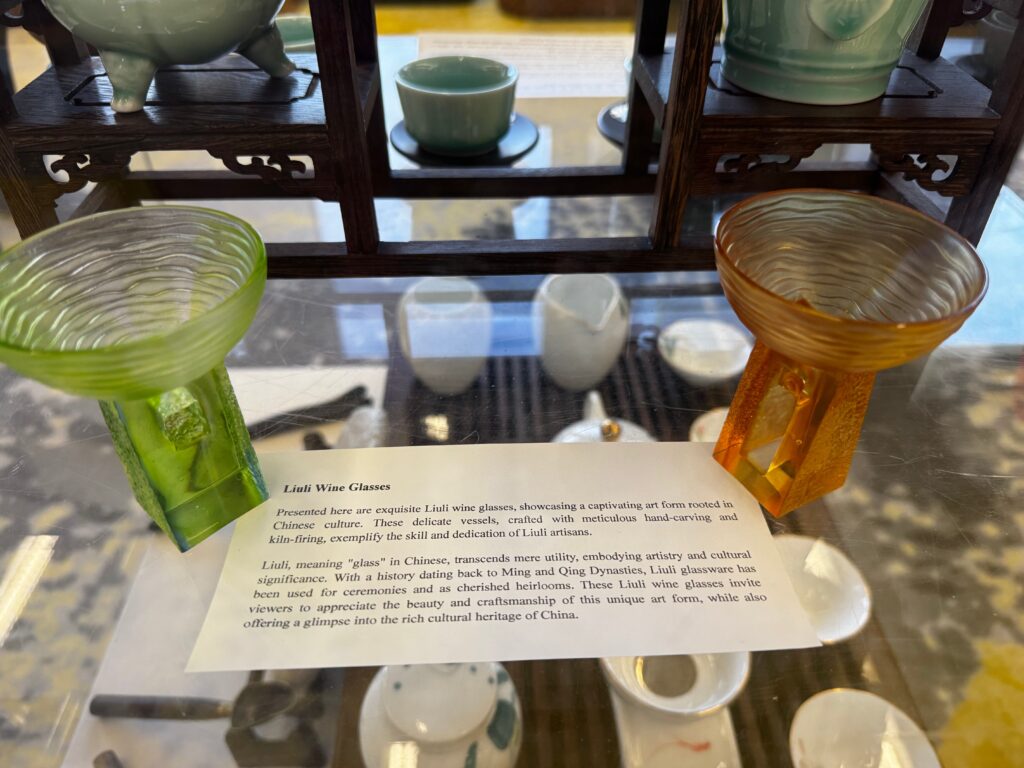
Presented here are exquisite Liuli wine glasses, showcasing a captivating art form rooted in Chinese culture. These delicate vessels, crafted with meticulous hand-carving and kiln-firing, exemplify the skill and dedication of Liuli artisans.
Liuli, meaning “glass” in Chinese, transcends mere utility, embodying artistry and cultural significance. With a history dating back to Ming and Qing Dynasties, Liuli glassware has been used for ceremonies and as cherished heirlooms. These Liuli wine glasses invite viewers to appreciate the beauty and craftsmanship of this unique art form, while also offering a glimpse into the rich cultural heritage of China.
Chinese Tea Categories and Their Most Famous Representations: 中国茶种类和著名茶品
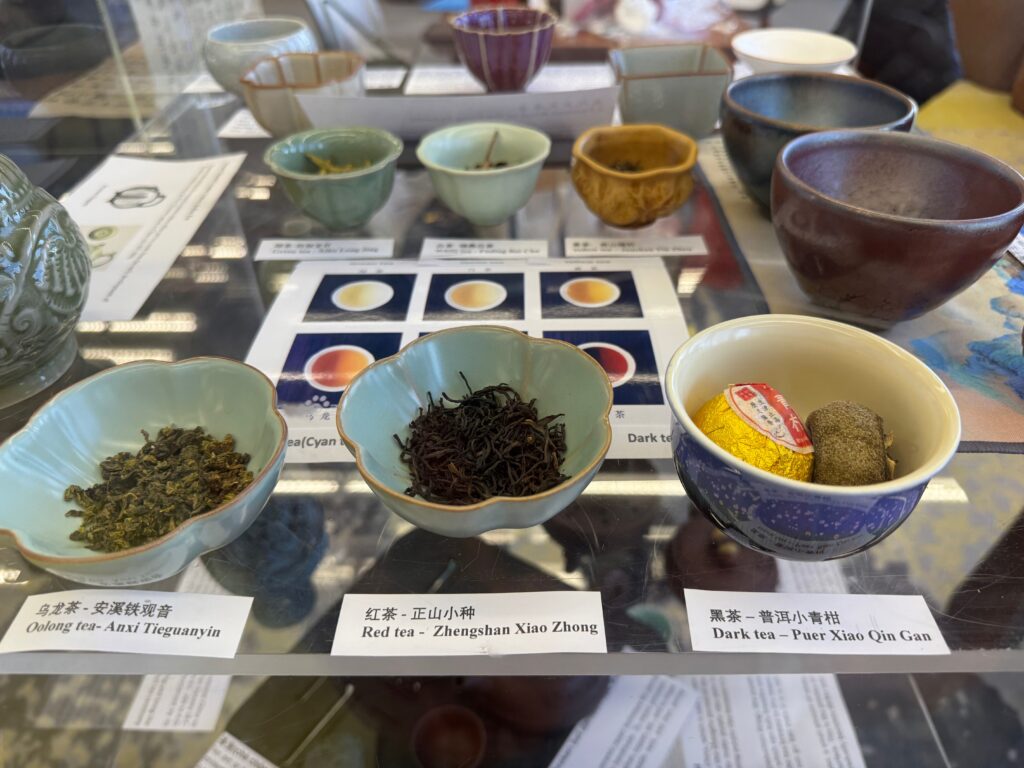
Green tea – Xihu Long Jing 绿茶-西湖龙井
White tea – Fuding Bai Cha 白茶- 福鼎白茶
Yellow tea – Junshan Yin Zhen 黄茶- 君山银针
Oolong tea- Anxi Tieguanyin 乌龙茶 – 安溪铁观音
Red tea – Zhengshan XiaoZhong 红茶 – 正山小种
Dark tea – Puer Xiao Qin Gan 黑茶 – 普洱小青柑
Green-glazed Ceramic Inverted Siphon Pot 倒灌壶
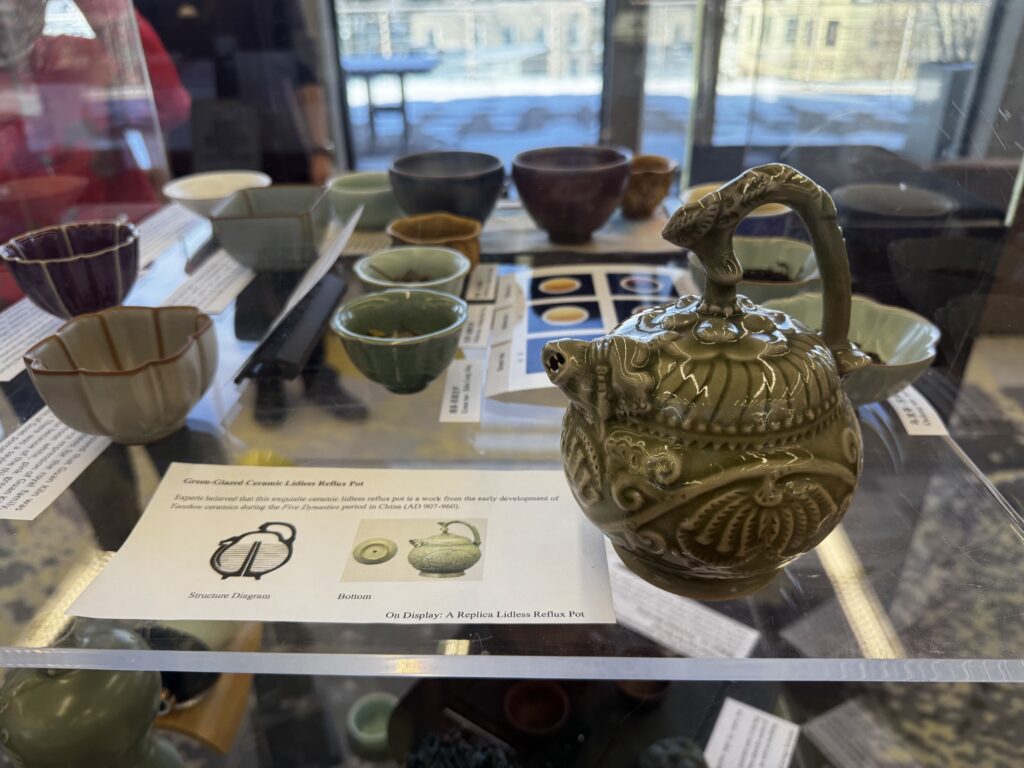
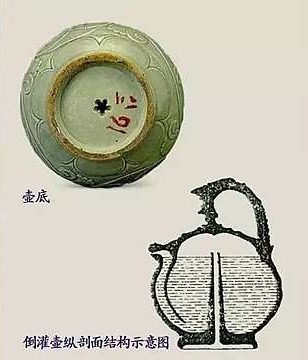
Experts believed that this exquisite ceramic invert siphon pot design is a work from the early development of Yaozhou ceramics during the Five Dynasties period of China (AD 907-960). Inverted Siphon pot operates using a clever mechanism that controls liquid flow through air pressure and gravity. When tea is poured into the upper chamber, it remains there until the air seal is broken, allowing the liquid to flow smoothly into the lower chamber. This unique design ensures a precise pour and prevents spills, demonstrating both practicality and the advanced engineering skills of early Chinese ceramicists. This pot is not only a functional tool but also a testament to the ingenuity of ancient Chinese artisans.
Volunteers: Jessie Zhang, Malida D, Rong Zhu, Lei Shi, YY Lee.

